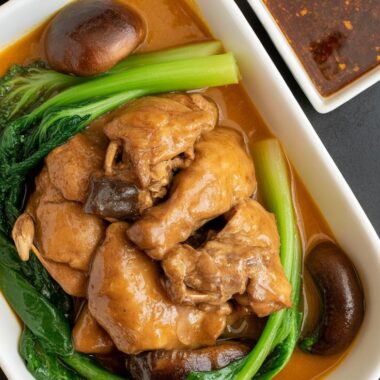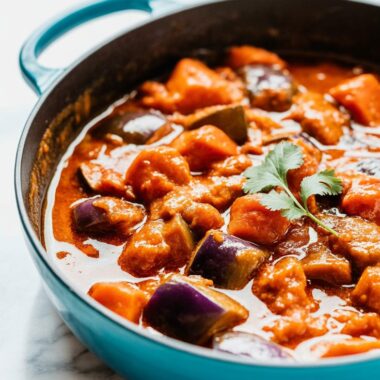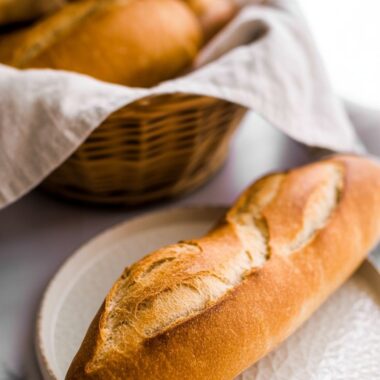There’s something about a steaming bowl of beef noodle soup that makes everything feel a little better. Whether it’s a rainy day or you’re just missing home, this Taiwanese classic has a way of wrapping you up in comfort. It’s hearty, rich, and layered with flavor from slow-cooked beef, spices, chewy noodles, and a broth that tastes like it’s been simmering for hours.
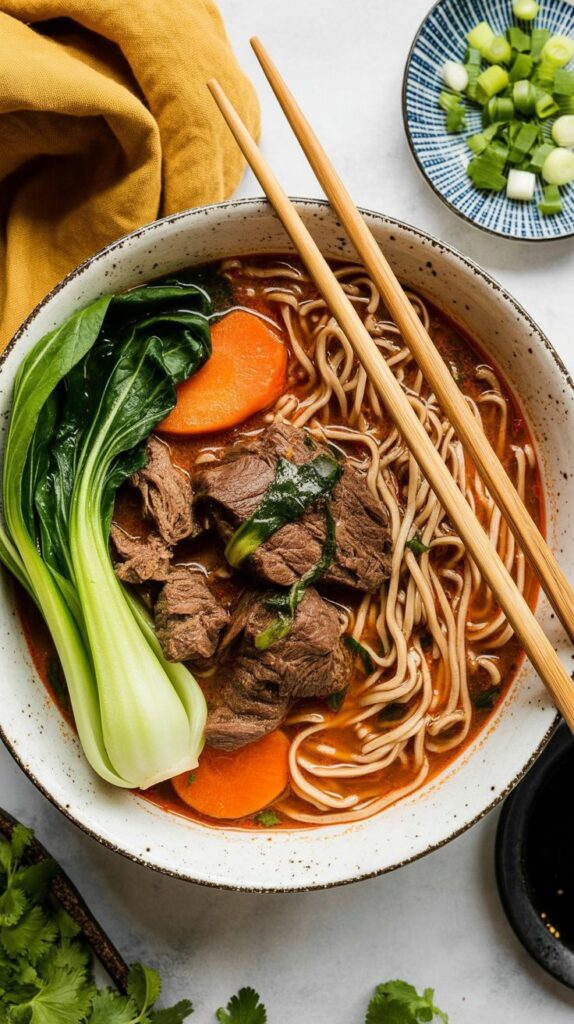
I grew up with dishes like this—family dinners where the aroma of soy, star anise, and garlic filled the whole house. This version leans on the red-braised style, the one I remember most fondly. It’s surprisingly doable in a home kitchen and even better than takeout if you ask me.
What Makes This Bowl Special
If you’ve never tried Taiwanese beef noodle soup before, think of it as the ultimate noodle comfort food. It’s got that beautiful balance of salty, slightly sweet, savory, and spiced. The beef is fall-apart tender, the broth is bold, and the noodles are that just-right chewy texture that holds everything together.
Some days I’ll toss in a handful of spinach, sometimes a hard-boiled egg, or whatever greens I have in the fridge. But the base? Always the same. Beef shank slow-braised in spices, soy sauce, and aromatics—it’s the soul of this soup.
Here’s What You’ll Need
Let me walk you through the key players in this dish and how to swap if needed.
Beef Shank (Boneless)
This cut is lean, full of connective tissue, and perfect for slow braising. Once it simmers, all that collagen breaks down and gives you melt-in-your-mouth bites and a broth with that satisfying body. Can’t find beef shank? Boneless chuck roast or stew meat work in a pinch.
Doubanjiang
This is the magic ingredient. It’s salty, spicy, funky (in the best way), and adds a lot of depth to the broth. I like using a mild version so the flavor builds without overwhelming everything. If your brand is extra spicy or salty, just dial it back a bit.
Aromatics and Spices
You’ll need garlic, ginger, onions, scallions, and a mix of spices—think five spice powder, dried chilies, cinnamon stick, and star anise. I keep star anise optional since we’re already using five spice, but I love the hint of licorice it brings.
Taiwanese Cooking Wine (Michu)
It brings a little sweetness and depth to the broth. Chinese cooking wine or dry sherry will get you close. I’ve even used sake when I was out of michu—it worked just fine.
Noodles
Traditional hand-cut or knife-sliced wheat noodles are the dream, but don’t stress. I’ve made this with rice noodles, ramen, and even spaghetti in a pinch. Just don’t overcook them—they should stay nice and chewy.
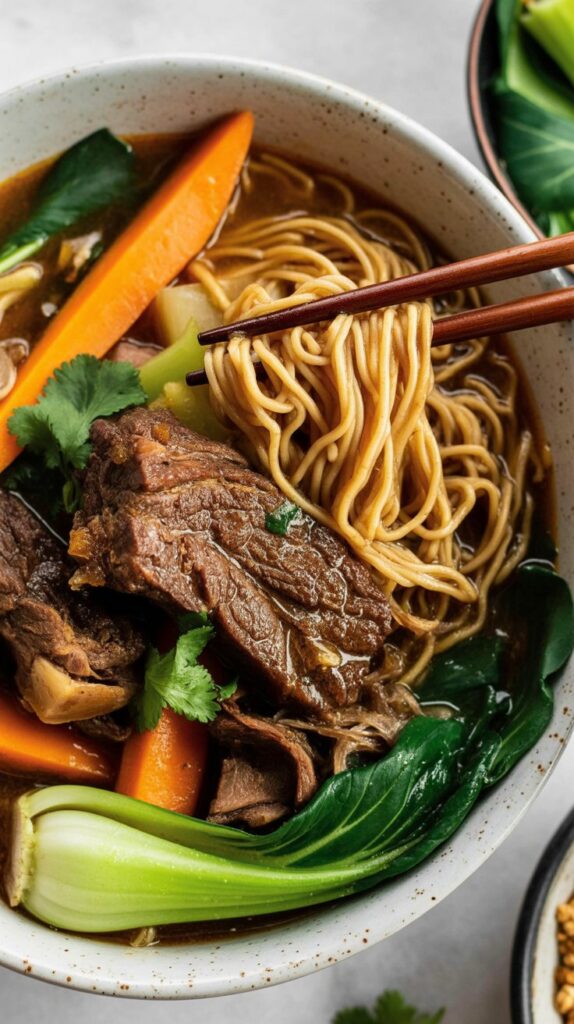
Step-by-Step: From Fridge to Soup Bowl
I know it sounds like a lot, but this recipe is more about layering flavors than hard technique. Here’s how I do it:
- Chop and Prep
Slice your aromatics: onion, garlic, ginger, and scallions (keep green and white parts separate). Dice tomatoes and carrots. I sometimes throw in a few dried shiitake mushrooms for extra umami. - Sear the Beef
Get your pan hot, then brown the beef pieces quickly on both sides. This locks in flavor and adds those delicious browned bits (fond) at the bottom of the pan that will deepen the broth. - Sauté the Base
In the same pan, toss in your chopped aromatics. Once fragrant, stir in the doubanjiang and tomatoes. Cook just until the tomatoes break down slightly and everything smells amazing. - Build It All Together
Transfer the beef, sautéed mix, carrots, mushrooms, and whole spices to your pressure cooker or soup pot. Stir your braising liquid (soy sauce, michu, sugar) and pour it in. - Pressure Cook or Simmer
If using an Instant Pot, set to high pressure for 40 minutes and let it naturally release for 15. If cooking on the stovetop, bring it to a boil, then simmer covered for 90 minutes or until the beef is tender. - Blanch and Boil
In another pot, blanch your greens (bok choy, spinach, or napa cabbage work well). In the same water, boil your noodles. This saves time and dishes. - Taste and Adjust
The broth will be strong. I usually taste and dilute with a cup or two of hot water until it feels balanced. - Assemble Your Bowl
Add noodles to a bowl, spoon in beef and vegetables, then pour over that gorgeous broth. Garnish with chopped scallions, fresh cilantro, and pickled mustard greens if you have them.
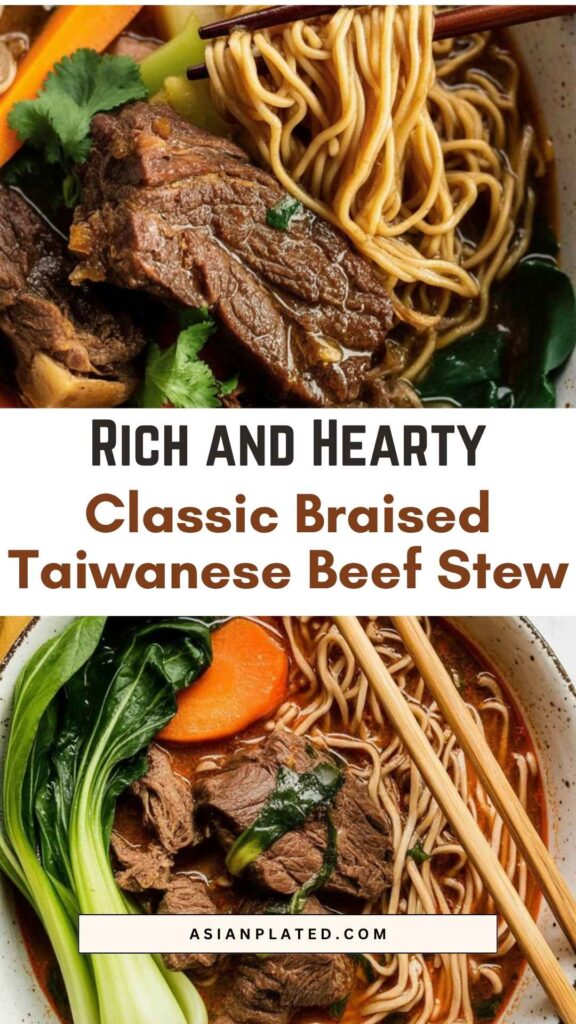
Real-Life Cooking Tips
Slice the Beef Just Right
About ½ inch thick is the sweet spot—thick enough to hold up to the braise, but thin enough to stay tender.
Don’t Skip the Sear
It adds that roasty flavor that brings everything together. If I’m short on time, I’ll still at least brown one side before moving on.
Taste as You Go
Every doubanjiang brand is different. Some are salty, others spicy. Start with less, then build up.
No Instant Pot? No Problem
The stovetop version works just as well—just give it a bit more time and check in to skim the top or stir occasionally.
How to Store and Reheat
This soup only gets better the next day. The flavors settle and deepen overnight in the fridge. Store it in an airtight container, and it’ll keep for up to 4–5 days. Reheat on the stove or in the microwave.
If you’re planning ahead, freeze just the broth and beef. Make the noodles fresh when you’re ready to eat—it keeps them from getting mushy.
Common Questions (And What I’d Say to Friends)
Can I make it less spicy?
Definitely. Use a mild doubanjiang and skip the dried chilies altogether.
What greens go best with this?
Bok choy is my go-to, but I’ve also used spinach, napa cabbage, and even kale once. Whatever you’ve got, just blanch it quickly so it doesn’t overcook.
What if I can’t find beef shank?
Chuck roast or stew meat will still give you a rich broth. Just aim for something with some marbling and connective tissue—it makes a difference.
Classic Braised Taiwanese Beef Stew
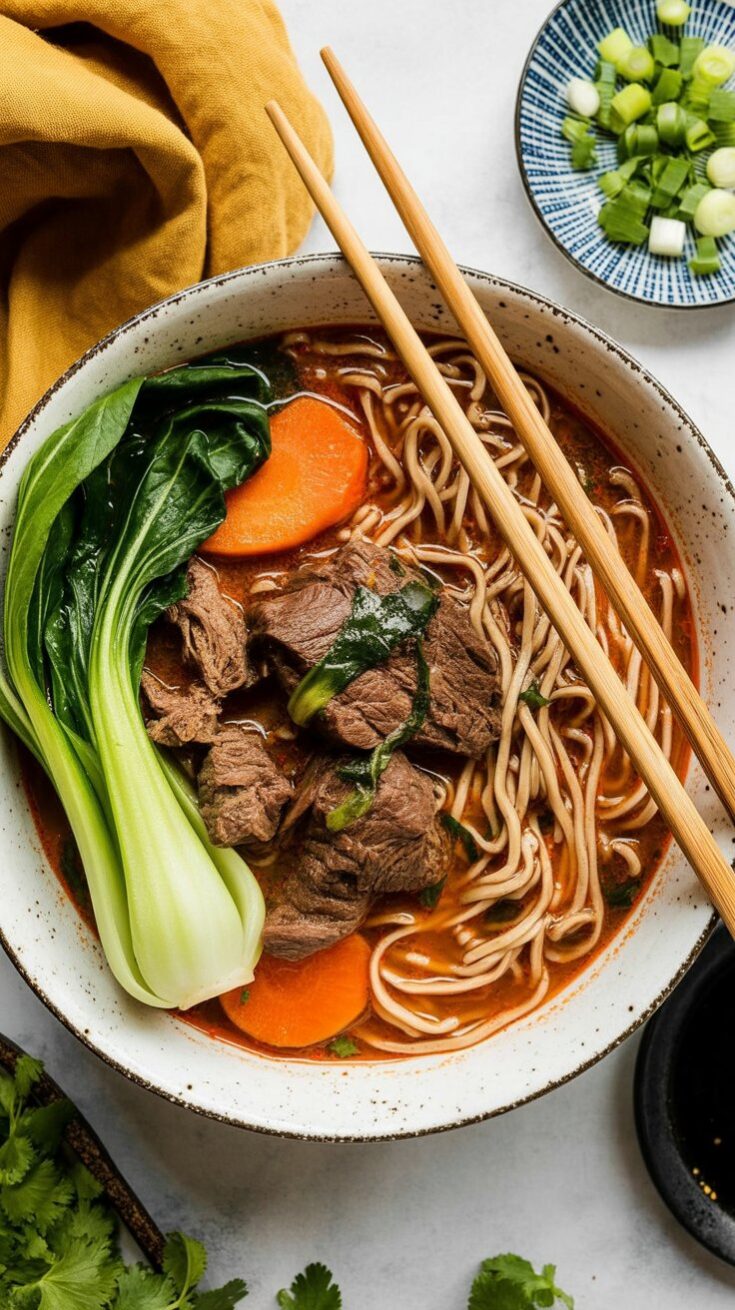
A bowl of Taiwanese beef noodle soup is pure comfort—deeply savory broth, melt-in-your-mouth braised beef, chewy noodles, and crisp greens.
Ingredients
Aromatics & Vegetables
- 4 vine-ripened tomatoes, roughly chopped
- 4–5 fresh shiitake mushrooms, sliced
- 3 medium carrots, cut into 1½-inch pieces
- ½ large yellow onion, sliced
- 10 large garlic cloves, roughly chopped
- 4–5 slices fresh ginger
- 4 Chinese dried chilies (or 2 red chilies like serrano/fresno, deseeded)
- 4 scallions, chopped (white and green parts separated)
Beef
- 2 lbs boneless beef shank (or chuck roast/beef stew meat), sliced slightly thicker than ½ inch
- ½ tsp coarse sea salt, divided
- ½ tsp ground black pepper, divided
Seasonings & Braising Liquid
- 1 tbsp avocado oil
- 2 tbsp doubanjiang (fermented chili bean paste)
- 1 cinnamon stick (3-inch)
- 1 bay leaf
- 2 star anise pods (optional)
- 1 cup beef stock
- ½ cup water
- ½ cup soy sauce
- ½ cup Taiwanese michu or Chinese cooking wine
- 1 tsp coarse sea salt (or to taste)
- 2 tsp five spice powder
- 2 tbsp brown sugar (or rock sugar)
For Serving
- Wheat noodles (Taiwanese sliced noodles, la mian, or your favorite)
- Blanched leafy greens (bok choy, baby spinach, etc.)
- Fresh cilantro (optional)
- Chinese pickled mustard greens (optional)
Instructions
- Get everything prepped: Start by prepping your aromatics—slice the onion, garlic, and ginger. Chop the scallions, keeping the white and green parts separate. Roughly chop the tomatoes and carrots. Slice the mushrooms and deseed the chilies.
- Season the beef: Cut the beef into thick slices and season with half the salt and pepper.
- Mix the braising base: In a bowl or large measuring cup, stir together beef stock, water, soy sauce, michu, salt, five spice powder, and sugar. Set it aside.
- Sear the beef: Heat avocado oil in a large sauté pan over medium heat. Once hot, increase the heat to medium-high and sear the beef—about 2 minutes on one side, then flip and sear for another minute. Set the beef aside.
- Sauté aromatics: In the same pan, toss in the onion, garlic, ginger, chili, and the white parts of the scallion. Sauté for about 3 minutes until fragrant. Add the tomatoes and doubanjiang, stirring for another 2 minutes until everything is well coated. Turn off the heat.
- Assemble in the Instant Pot: Transfer the sautéed mixture into your Instant Pot along with the seared beef. Add carrots, mushrooms, cinnamon stick, bay leaf, and star anise. Pour in the braising liquid and give it a quick stir to distribute everything evenly.
- Pressure cook: Seal the Instant Pot and cook on High Pressure for 40 minutes. Let it naturally release for 15 minutes, then manually release any remaining pressure.
- Boil noodles & blanch greens: While the beef cooks, boil your noodles according to package directions. In a separate pot, quickly blanch your vegetables. Set both aside.
- Taste & adjust the broth: Once cooked, open the lid and taste the broth. If it’s too concentrated, add 1.5 to 2.5 cups of hot water to balance the flavor.
- Serve it up: Place noodles in bowls, ladle over the beef and broth, and top with your greens. Garnish with cilantro and serve pickled mustard greens on the side if you'd like.
Nutrition Information:
Yield: 6 Serving Size: 1Amount Per Serving: Calories: 840Total Fat: 18gSaturated Fat: 5gTrans Fat: 0gUnsaturated Fat: 9gCholesterol: 118mgSodium: 2366mgCarbohydrates: 103gFiber: 16gSugar: 19gProtein: 68g
Asianplated.com, occasionally offers nutritional information for recipes contained on this site. This information is provided as a courtesy and is an estimate only. This information comes from online calculators. Although allchickenrecipes.com attempts to provide accurate nutritional information, these figures are only estimates.
Why This Soup Feels Like Home
I’ve made this soup when I’ve missed home, when I’ve wanted to impress dinner guests, and even when I just needed something to sip on a quiet Sunday night. It’s got that warm, familiar feel to it—like a hug in a bowl.
Whether it’s your first time trying Taiwanese beef noodle soup or you’re recreating a memory, I hope this version brings you the same kind of comfort it brings me.
Try other Taiwanese recipes:







